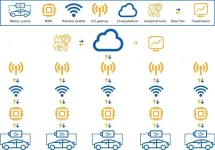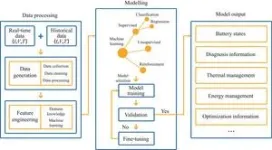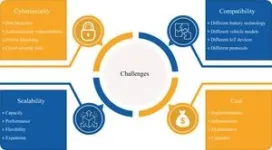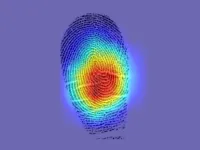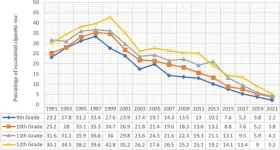(Press-News.org)
A paper describing the architectures, opportunities, and challenges of the IoB was published in the journal Green Energy and Intelligent Transportation on September 7th, 2023.
The present battery technology employed in electric vehicles (EVs) faces several critical challenges. Firstly, the limited operation range of EVs remains a major concern for potential users, as it affects their ability to travel long distances without the need for frequent recharging. Additionally, long charging times are inconvenient for users and can hinder the widespread adoption of EVs. Alongside these limitations, the possibility of battery faults such as thermal runaway, can lead to safety risks including fires or explosions. These factors, including technical concerns about battery health and safety, the need for frequent recharging, and long charging times, could discourage potential users from adopting EVs. Furthermore, EV batteries experience degradation over time, resulting in decreased performance and battery lifespan reduction. It leads to an increase in maintenance and accident risk for EV owners.
As a promising solution to these issues, the IoB is a networked system that utilizes the principles of the Internet-of-Things (IoT) to gather data from EV batteries. This data is subsequently transmitted to a cloud server, where it is utilized for battery state estimation, predictive analytics, and fault diagnosis. In contrast to traditional battery management systems (BMS), IoB leverages advanced technologies like IoT, cloud computing, and machine learning to provide intelligent battery management.
The IoB can be defined as an integrated system that uses the IoT and cloud computing technology to monitor and manage batteries. IoB systems can collect data from batteries in real-time, such as voltage, current, temperature, and other parameters. This data can be used to analyze battery health and performance, identify potential faults, and optimize battery usage. IoB systems can also be used to remotely control batteries. This can help to improve battery efficiency and extend battery life.
The IoB comprises three main components, battery systems, IoT gateway, and cloud platform, and two additional components, i.e. BMS and wireless module, which are integrated inside the battery systems. Firstly, battery systems form the foundational layer of the IoB architecture, particularly within the context of EVs. Secondly, the wireless module is a critical component of the IoB system for EVs. Thirdly, the IoT gateway serves as a bridge between the wireless module and the cloud platform, ensuring safe and efficient transmission of data. Finally, the cloud platform provides a centralized hub for storing, processing, and analyzing battery data collected from various EVs.
Machine learning is a powerful tool that can be used to improve the efficiency and effectiveness of IoB systems. By analyzing data and learning from patterns, machine learning can help IoB systems make more informed decisions about battery management, charging, usage, and vehicle management. This can lead to improved battery performance, increased range, and reduced costs for EV owners. Machine learning approaches can be broadly classified into three maincategories: supervised learning, unsupervised learning, and reinforcement learning.
The IoB present numerous promising opportunities, particularly for the EV industry. This digital technology promise benefits such as ongoing battery health checks, improved energy management, state estimation, prediction, and faultdiagnosis, significantly transforming the landscape of EV technology.
However, implementing the IoB in EVs presents a number of challenges. The innovative integration of IoT technologies within the BMS of EVs presents a wide range of challenging issues that need to be thoroughly addressed for the technology to achieve a reliable state and widespread use. One of the most prominent concerns in the IoB domain is the security of battery data. Another significant challenge lies in the compatibility between different systems. Lastly, the large-scale application of IoB in EVs comes with its own set of technical complexities.
In the future, more research and development will be needed to fully realize the potential of the IoB and optimize battery use in EVs. Future efforts should focus on addressing the challenges, such as data security and system compatibility. Additionally, research should explore the potential role of artificial intelligence and machine learning in enhancing the efficiency and effectiveness of IoB systems. The IoB has the potential to transform the EV industry, but realizing this potential will depend on addressing these challenges and seizing the opportunities it offers.
###
Reference
Authors: Heng Li a, Muaaz Bin Kaleem a, Zhijun Liu a, Yue Wu b, Weirong Liu a*, Zhiwu Huang c
Affiliations:
a School of Computer Science and Engineering, Central South University, Changsha, 410083, China
b Department of Energy Technology, Aalborg University, Aalborg 9220, Denmark
c School of Automation, Central South University, Changsha, 410083, China
Title of original paper: IoB: Internet-of-batteries for electric Vehicles–Architectures, opportunities, and challenges
Article link: https://www.sciencedirect.com/science/article/pii/S2773153723000646
Journal: Green Energy and Intelligent Transportation
DOI: 10.1016/j.geits.2023.100128.
END
The boundary between everyday reality and the quantum world remains unclear. The more massive an object, the more localized it becomes when being made quantum through cooling down its motion to the absolute zero. Researchers, led by Oriol Romero-Isart from the Institute for Quantum Optics and Quantum Information (IQOQI) of the Austrian Academy of Sciences (ÖAW) and the Department of Theoretical Physics at the University of Innsbruck, propose an experiment in which an optically levitated nanoparticle, cooled to its ground state, evolves in a non-optical (“dark”) potential created by electrostatic or magnetic forces. This evolution in the dark potential ...
Columbia engineers have built a new AI that shatters a long-held belief in forensics–that fingerprints from different fingers of the same person are unique. It turns out they are similar, only we’ve been comparing fingerprints the wrong way!
New York, NY—January 12, 2024—From “Law and Order” to “CSI,” not to mention real life, investigators have used fingerprints as the gold standard for linking criminals to a crime. But if a perpetrator leaves prints from different fingers in two different crime scenes, these scenes are very difficult to link, and the trace can go ...
JMIR Publications is pleased to announce that JMIR Mental Health (JMH) has been accepted for inclusion in MEDLINE, which is the U.S. National Library of Medicine's premier bibliographic database.
JMIR Mental Health had already been indexed in PubMed previously. MEDLINE is a more selective subset of PubMed, consisting of the top 5,200 biomedical journals. Indexing in MEDLINE also means that articles are now also indexed with NLM Medical Subject Headings (MeSH terms) and other metadata.
Selection for MEDLINE is a result of a thorough review of the ...
Reducing stimulant use was associated with significant improvement in measures of health and recovery among people with stimulant use disorder, even if they did not achieve total abstinence. This finding is according to an analysis of data from 13 randomized clinical trials of treatments for stimulant use disorders involving methamphetamine and cocaine. Historically, total abstinence has been the standard goal of treatment for substance use disorders, however, these findings support the growing recognition that a more nuanced perspective on measuring treatment success may be beneficial.
The study, published in Addiction, was led by scientists at the Johns Hopkins Bloomberg School of Public ...
Boston – Like a criminal entering a witness protection program, cancer cells can shed their past and take on a new identity. Detecting such an identity-switch is particularly challenging when metastatic castration-resistant prostate cancer (CRPC) advances from adenocarcinoma to neuroendocrine prostate cancer (NEPC), a very difficult cancer to treat.
Now, however, researchers at Dana-Farber Cancer Institute and the University of Trento, Italy, have developed a blood test, described in Cancer Discovery, that can ...
Cigarette smoking remains the leading avoidable cause of premature death in the United States, accounting for approximately 500,000 deaths or 1 in 5 deaths annually. According to the U.S. Department of Health and Human Services, most adults who smoke cigarettes started before age 18, so preventing cigarette smoking in adolescents is important to reducing smoking in adults.
In a new study, researchers from Florida Atlantic University’s Schmidt College of Medicine and collaborators explored overall trends in cigarette smoking among a large sample of U.S. adolescents in grades nine to 12 from 1991 to 2021. They ...
Many edible, medicinal, and poisonous mushrooms that we are familiar with belong to the order Agaricales, which is a group of fungi with important economic and ecological value. Understanding the phylogenetic relationships of Agaricales can help us to know their evolutionary history and diversity, as well as their interactions with other organisms. Moreover, the phylogenetic framework of Agaricales can provide a basis for conserving biodiversity, such as measuring phylogenetic diversity and assessing the uniqueness and importance of different species.
Previous studies divided Agaricales into 8 suborders and 46 families, but the systematic position and phylogenetic relationship ...
Québec, January 10, 2024 – In people with amyotrophic lateral sclerosis (ALS), changes in neurons appear to activate immune cells. Lowering the inflammation could reduce the symptoms of the disease, according to a study led by Chantelle Sephton, a professor at Université Laval's Faculty of Medicine.
ALS is caused by the loss of upper motor neurons, located in the brain, and lower motor neurons, which extend from the spinal cord to the muscles. Using a genetically modified mouse ...
The frigid Arctic Ocean is far removed from the places most people live, but even so, “forever chemicals” reach this remote landscape. Now, research in ACS’ Environmental Science & Technology Letters suggests that per- and polyfluoroalkyl substances (PFAS) won't stay there indefinitely. Instead, they are transported in a feedback loop, with the Arctic Ocean potentially exporting as many PFAS to the North Atlantic Ocean as it receives, circulating the compounds around the world.
To ...
Trailblazing engineer Ashok Veeraraghavan, Ph.D., Professor of Electrical and Computer Engineering and Computer Science, George R. Brown School of Engineering at Rice University, is the recipient of the 2024 Edith and Peter O’Donnell Award in Engineering from TAMEST (Texas Academy of Medicine, Engineering, Science and Technology). He was chosen for his revolutionary imaging technology that seeks to make the invisible visible. View a video on Dr. Veeraraghavan's groundbreaking research here.
Imagine taking a pristine picture through fog, smoke and rain. Imagine taking interior images of the human body through skin, bone ...
